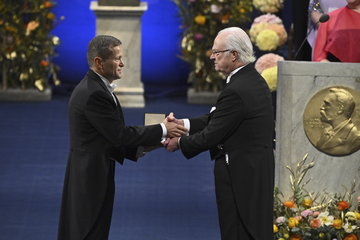Gruber Genetics Prize for Svante Pääbo
Geneticist Svante Pääbo from the Max Planck Institute for Evolutionary Anthroplogy is to receive the US$500,000 Gruber Genetics Prize for groundbreaking research in evolutionary genetics
Svante Pääbo is the recipient of the 2013 Genetics Prize of The Gruber Foundation. Pääbo is being honoured with this prestigious international award for his pioneering research in the field of evolutionary genetics. He is considered the founder of molecular paleontology, the application of genetics to the study of prehistoric life. The award will be presented to Pääbo on April 16 at the International Congress of Genetics conference in Singapore, where he will also deliver a lecture entitled "Archaic Genomics."

"Svante Pääbo's work shows basic science at its best. He is driven by an obvious passion to use DNA technology to unlock the past. He overcame seemingly insuperable technical obstacles. And he opened new vistas on a question we all care about, 'Where do we come from?' This is a wonderful award," said Maynard Olson, a member of the selection advisory board and 2007 laureate of the Gruber Genetics Prize.
Pääbo, 57, started experimenting with extracting DNA from ancient human remains in the early 1980s while completing his PhD program in molecular immunology at the University of Uppsala in Sweden, his native country. His first major finding — the demonstration that DNA was preserved in a 2,400-year-old mummy of an infant boy — was published as the cover story in Nature in 1985. In the ensuing two-and-a-half decades — at the University of California at Berkeley, the University of Munich and, since 1997, at the Max Planck Institute for Evolutionary Anthropology in Leipzig — Pääbo has played a leading role in developing the technology that has made it possible to isolate and sequence ancient DNA.
In 1997, Pääbo announced the successful sequencing of mitochondrial Neandertal DNA — a turning point in evolutionary genetics. In addition to proving that the DNA could be successfully extracted and sequenced from a 40,000-year-old fossil, the sequencing showed that Neandertals and humans were distinctly different groups. Over the next decade, with the help of new gene-sequencing technology, Pääbo led efforts to sequence Neandertal’s nuclear DNA. In 2010, he and his colleagues at the Max Planck Institute published the draft sequence of that genome, along with the startling finding that Neandertals have contributed up to 4 percent of the genetic material in modern humans. That same year, Pääbo and his team reported a second remarkable finding: A DNA analysis of a finger bone found in 2008 in a Siberian cave showed that it had belonged to a previously unknown form of hominins. It was the first time an extinct hominin group had been identified by genetic analysis alone.
Pääbo is also recognized as one of the world’s leaders in human molecular evolution. He has, for example, played a critical role in defining the genetic relationship between humans and great ape populations. In addition, he has identified and studied the function of genes critically important in the evolution of the human species, such as FOXP2, which is associated with language development. In 2008, Pääbo reported that Neandertals had an identical FOXP2 gene, which raised the tantalizing possibility that they may have had some language capabilities.
"Pääbo's bold and exciting research has changed the way we understand human evolution and is providing insight into genes that are critical in the evolution of the human species," said Huda Zoghbi, chair of the Selection Advisory Board and the 2011 laureate of the Gruber Neuroscience Prize.












